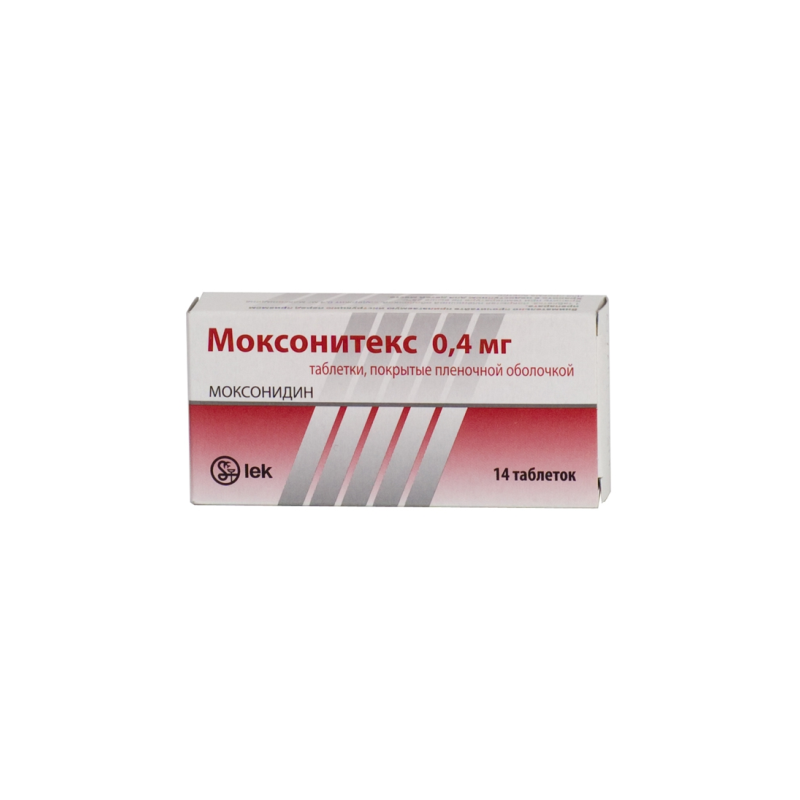



 All payments are encrypted via SSL
All payments are encrypted via SSL
 Full Refund if you haven't received your order
Full Refund if you haven't received your order
MOKSONITEX - selective imidazoline receptor agonist. It is responsible for reflex control over the sympathetic nervous system (the receptors are localized in the ventero-lateral division of the medulla oblongata). Slightly binds to central α2-adrenoreceptors, reduces systolic and diastolic blood pressure in a single and prolonged use.
With long-term use, it reduces left ventricular myocardial hypertrophy, eliminates the signs of myocardial fibrosis of microarteriopathy, normalizes capillary blood supply to the myocardium, reduces OPSS, pulmonary vascular resistance, while cardiac output and heart rate do not change significantly.
The treatment reduces the activity of norepinephrine and epinephrine, renin, angiotensin II at rest and with exercise, atrial natriuretic peptide (with exercise) and aldosterone of blood plasma.
Reduces insulin resistance of tissues by 21% compared with placebo in obese patients and insulin-resistant patients with moderate arterial hypertension, stimulates the release of growth hormone. Does not affect the exchange of glucose and lipids.
Duration of action - more than 12 hours.
Indications
Arterial hypertension.
Contraindications
- angioedema in history;
- SSS or sinoatrial block;
- AV blockade II and III degree;
- severe bradycardia (less than 50 beats / min at rest);
- pronounced cardiac arrhythmias;
- chronic heart failure (III-IV functional class according to the NYHA classification);
- unstable angina;
- severe liver failure;
- renal failure severe (CC less than 30 ml / min, serum creatinine content - more than 160 μmol / l);
- age up to 18 years;
- lactation period;
- galactose intolerance, lactase deficiency or glucose-galactose malabsorption syndrome;
- Hypersensitivity to Moxonidine or any other component of the drug.
With caution and under the supervision of a physician should use the drug in patients after a recent myocardial infarction or in violation of peripheral circulation (intermittent claudication, Raynaud's syndrome); in patients with moderately severe renal dysfunction (CC 30–60 ml / min; serum creatinine content 105–160 mcmol / l), with impaired liver function, during pregnancy, depression, glaucoma, epilepsy, Parkinson’s disease.
Dosage and administration
Moxonitex is prescribed by mouth, regardless of the meal, with a sufficient amount of liquid. Dosing regimen is selected individually.
The initial dose is 200 mcg in the morning.With insufficient therapeutic effect, the dose after 3 weeks is increased to 400 μg / once or in 2 doses. The maximum daily dose is 600 mcg, the maximum single dose is 400 mcg.
In patients with moderately severe renal impairment (CC 30-60 ml / min), a single dose should not exceed 200 mcg, the maximum daily dose - 400 mcg.
Side effects
Since the cardiovascular system: rarely - symptoms of vasodilation; sometimes - pronounced decrease in blood pressure, syncope, Raynaud's syndrome, peripheral edema.
From the side of the central nervous system: often - dizziness, headache, drowsiness, fatigue, sleep disturbance; sometimes - paresthesia, depression, anxiety.
On the part of the digestive system: often - dryness of the oral mucosa, nausea, anorexia, constipation.
On the part of the urogenital system: sometimes - the delay or incontinence of urine, impotence and / or decreased libido.
On the part of the senses: sometimes - dry eyes, causing itching or burning sensation.
Allergic reactions: sometimes - urticaria, pruritus, rash, angioedema.
Other: sometimes - gynecomastia, pain in parotid glands.
Drug interaction
When co-prescribed moxonidine with other antihypertensives, there is a mutual enhancement of action.
Beta-adrenergic blockers enhance bradycardia, the severity of negative insomnia and dromotropic action.
Moxonidine enhances the hypotensive effect of ethanol, sedatives, slow Calcium channel blockers (dihydropyridine derivatives).
Moxonidine should not be used simultaneously with tricyclic antidepressants.
Tolazolin dose-dependently reduces the hypotensive effect of moxonidine.
Overdose
Symptoms: headache, marked reduction in blood pressure, bradycardia, palpitations, weakness, drowsiness, dryness of the oral mucosa; rarely - vomiting and pain in the epigastrium. Potentially possible paradoxical hypertension and hyperglycemia.
Treatment: symptomatic. There is no specific antidote. With a pronounced decrease in blood pressure it is recommended to restore the BCC due to the introduction of fluid. Α-adrenoreceptor antagonists can reduce or eliminate transient hypertension in overdose with moxonidine.
Storage conditions
The drug should be stored out of the reach of children at a temperature not higher than 25 ° C.
